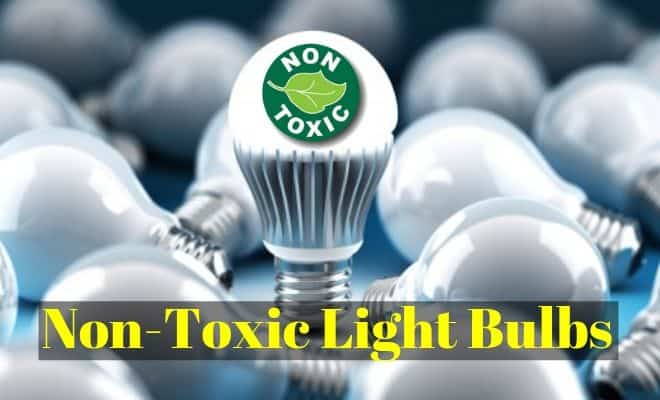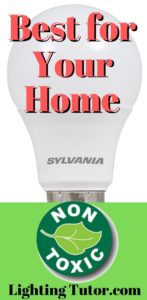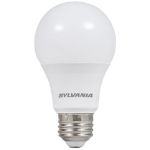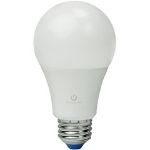Last Updated on April 2, 2020 by The Tutor
Non Toxic Light Bulbs

Could you imagine a world where there was no light? Of course, a few hundred years ago that was exactly the case – no light without a candle! But now in a world of electricity and technology it seems outlandish to go without light bulbs. If you’re concerned about the safety of light bulbs, you should know the right bulbs to buy and how to protect yourself.
Non toxic light bulbs are quickly replacing incandescent and LED light bulbs because they are free of mercury and other unhealthy toxins found in other bulbs, while also reducing blue light emission. They are a far healthier options for humans and the environment.
So, what’s the down-low on light bulbs? If you’ve never heard about the dangers of light bulbs, you might seem confused. We’re going to discuss why certain light bulbs are dangerous, how to lessen your risk, which light bulbs you should be using, and which are considered to be non toxic light bulbs.
Are Light Bulbs Bad for Your Health?
To put it simply, yes some light bulbs are toxic. Incandescent light bulbs have traces of mercury inside of them, which is incredibly toxic for humans. While some researchers say that the mercury is contained unless the light bulb is broken, it’s still not a great choice to have anything inside of the home that contains that much mercury.
Florescent light bulbs are also known to contain mercury. There are warning about breaking these bulbs because the gas contained within them will carry the toxic mercury.
LED light bulbs, on the other hand, were said to be the ‘healthier’ option for many years, especially in terms of environmental footprint. However, many of these light bulbs have several other harmful toxins inside, including lead, nickel, and many others.
Is LED Light Harmful to Health?
LED lights are probably the most common type of light bulb as of right now, but unfortunately, they may be negatively affecting our health, especially when it comes to the eyes.
LED light bulbs emit blue light, and that is the hot topic of discussion when it comes to the overall safety of having LED light bulbs inside of the home.
The simple matter of the fact is this: blue light is found naturally emitted from the sun each day to keep us alert; think of it as a natural caffeine. However, when you go home and turn on your LED light bulbs, you’re still receiving blue light activity which can disrupt your regular sleeping rhythm and make it harder to fall asleep.
There has also been a lot of research done on the impact of excessive blue light on the retina of the eye, and there are certainly negative side effects. Some people have had fairly serious eye problems since switching to LED light thanks to the blue light emission.
That being said, LED lights are considered to be non toxic light bulbs and are the best choice today if yuo are looking for a bulb that reduces health risks.
Do LED Lights Give off EMF?
There has been very little research done on whether or not LED light bulbs truly give off EMF (electromagnetic fields), otherwise known as ‘radiation.’ However, most research has shown that the majority of LED Light bulbs give off a very small dose of EMF.
This, of course, can still be an issue as extra radiation is never a good thing for the human body. EMF is a major cause of concern with LED light bulbs and is another reason why many individuals are seeking out a new light bulb for their homes and businesses.
Are Incandescent Light Bulbs Toxic?
Yes, it has been proven that incandescent light bulbs are toxic. There are trace amounts of mercury found inside of this type of light bulb, which is why they have been recently replaced by LED light bulbs which are found to be healthier for humans and the environment.
While a lot of researchers may tell you that incandescent light bulbs are only a potential problem when broken open, it’s never a good idea to have mercury inside of the home. This is an extremely dangerous toxin that wreaks havoc on the body.
Incandescent light bulbs are also harmful to the environment. They require a lot of power and energy to use, which means the environmental footprint is astounding and causing quite a stir to nature.
How to Minimize Risks
If you’re still opting for an LED light bulb, despite the amount of harmful effects being placed on your body and health, there are several steps you can take:
- Don’t have the LED light bulb near your face. The closer the light bulb is, the more blue light will be hitting against your body, specifically the eye region.
- Turn off the lights. When you can, try to use the LED lights as little as possible. This means that when you’re ready for bed, all lights should be shut off to help you get a better night’s sleep.
- Try to find an LED light bulb with low levels of emission. Look for an LED light bulb with a color temperature of 2400K and a high CRI level. These light bulbs emit less blue light. They will sometimes be labeled as ‘warm white.’ Also check the M/P ratio, which should be 0.4 or lower.
What is the Healthiest Light Bulb?
The new and upcoming way of light bulbs is non-toxic bulbs. These are made to be mercury-free, free of any and all other toxins (such as lead and nickel which are found in LED light bulbs) and do not emit any blue light. To put it simply, they are the ideal light bulb for not only humans and health, but the environment as well.
Popular Non Toxic Light Bulbs
As of right now, these are the most popular light bulbs that have an extremely low rate of blue light emission and are said to be completely toxin-free.
These LED light bulbs come with 2700K color temperature, which means they are safer than most other light bulbs on the market. They are also lead- and mercury-free, which is a huge issue for homeowners and business owners.
These LED light bulbs are superior in terms of energy efficiency, with a total lifespan of up to 11,000 hours. Soft white and safe for homes, this affordable 4-pack is exactly what you need in your living space.
Check the price on Amazon here
With only 2400K color temperature, this is undoubtedly the best option for LED light bulbs as it won’t emit much blue light. Completely dimmable, this gives you the option to create a luxurious ambiance in your home while still saving money.
The Green Creative 40741 A19 LED light bulb is certainly a healthier option, while also creating a more energy-efficient place to live or do business.
Check the price on Amazon here
This is another excellent option thanks to the 2400K color temperature, but the great thing about this particular light is it has a vintage look that is aesthetically pleasing and complements any room of the home, even the outdoors.
Energy efficiency is key with this LED light bulb, and with low emissions and a classy old school appearance, it’s a great choice. Not to mention this pack of light bulbs is extremely affordable and an easy way to change the entire look of any space instantly.
Check the price on Amazon here
Conclusion
When it comes to light bulbs, the wave of the future comes in non-toxic options. While that’s still in motion, the best thing you can do is avoid incandescent light bulbs altogether as they’re unsafe for humans and the environment. When it comes to LED light bulbs, keep yourself safe from potential harm by finding a 2400K color temperature bulb with high CRI and an M/P ratio of 0.4.
Related Articles
How to Choose The Right Light Bulb for Every Room
The Best Lighting for Migraine Headaches



